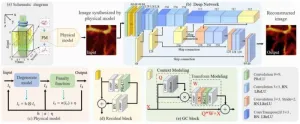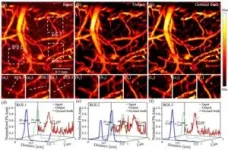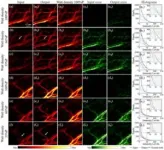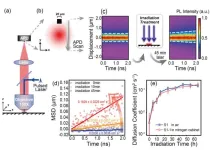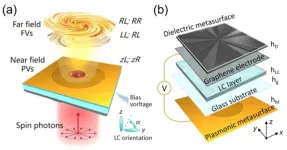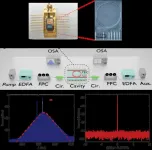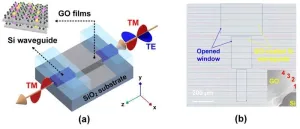A new publication from Opto-Electronic Advances; DOI 10.29026/oea.2025.240189, discusses enhanced photoacoustic microscopy with physics-embedded degeneration learning.
In recent years, photoacoustic imaging (PAI), as an emerging imaging technology, has gradually attracted widespread attention across various fields, particularly in interdisciplinary areas such as medicine, physics, and chemistry. In brief, PAI combines the unique advantages of both optics and acoustics. The fundamental principle of PAI is as follows: when laser light is applied to a target (such as human tissue), a portion of the optical energy is absorbed and converted into heat, leading to a local increase in temperature, which in turn causes pressure fluctuations in the region, generating sound waves. These sound waves are then detected by ultrasound sensors and converted into images, reflecting the internal structure and functional state of the target. PAI takes advantage of the differences in light absorption properties across various tissues, which provides high-resolution images during vivo imaging. At the same time, it offers strong depth penetration, making it a highly promising non-invasive imaging technique
Photoacoustic microscopy (PAM), as a modality of photoacoustic imaging (PAI), offers relatively high spatial resolution. PAM focuses laser light onto an extremely small area, enabling the acquisition of highly detailed images at the micron or even nanometer scale. Consequently, PAM has broad applications in tissue and cellular-level observation. As an extension of PAI, PAM retains the advantages of PAI, such as millimeter-level penetration depth, while offering exceptional spatial resolution, making it an indispensable tool in biomedical research, particularly in the exploration of cellular and tissue microstructures.
However, challenges such as signal attenuation and noise still persist during deep tissue imaging. To address these issues, researchers have explored a range of new technologies and methods, including the development of high-performance photoacoustic detectors, algorithm optimization, and image processing techniques based on deep learning. However, PAM still faces certain limitations in terms of accuracy, image quality, and signal-to-noise ratio for deep tissue imaging. These challenges somewhat restrict its potential applications in preclinical research and disease diagnosis. Therefore, improving the overall performance of PAM technology remains a core focus of current research.
To address the challenges mentioned above, Prof. Qian Chen and Prof. Chao Zuo's research group at Nanjing University of Science and Technology proposed a novel and efficient Physical Embedded Degradation Learning (PEDL) method. This method seamlessly integrates physical principles and domain-specific knowledge from PAM into a deep learning (DL) model. By fully utilizing the optical and acoustic properties of tissues, the team developed a physically embedded degradation mechanism and designed a specialized data model to simulate degradation in PAM, thereby enabling a more accurate simulation of the physical processes involved in PAM. The proposed PEDL neural network is based on the U-Net architecture [Fig. 1], incorporating multiple residual blocks and a Global Context (GC) self-attention enhancement module. Multiple residual blocks effectively extract complex features in PAM images, while also efficiently mitigating the vanishing gradient problem. Additionally, the GC self-attention mechanism captures the global contextual information of the feature map, enabling PEDL to better comprehend the overall structure of PAM images.
PEDL enhances the generalization ability of deep learning (DL) models, enabling them to make reliable predictions in unknown scenarios, particularly for the applicability of acoustic and optical resolution PAM systems. For example, it can address various types of noise interference, scattering variations in biological tissues, and fluctuations in laser energy. Fig. 2 illustrates the reconstruction effect diagram under severe degeneration. A significant improvement is observed from Fig. 2(a) to Fig. 2(b). As shown in Figs. 2(a1)-(a3), (b1)-(b3), and (c1)-(c3), the resolution is notably enhanced in the zoomed-in areas. Figures 2(d)-(f) demonstrate that after network reconstruction, the original noisy regions have been effectively denoised, significantly improving the image resolution. In Figs. 2(a)-(c), the yellow arrows indicate blood vessels that are difficult to distinguish due to noise interference; however, after network reconstruction, the image becomes much closer to the ground truth. In Figs. 2(d)-(f), regions marked with orange arrows show that noise has been effectively removed, and the full width at half maximum (FWHM) of the blood vessels has been well restored.
Fig. 3 shows the effect diagram and reconstruction diagram under different laser energy. From Fig. 3 (a)-(f) to 3(a1)-(f1), small signals are enhanced, and the overall image resolution is improved. Notably, from Fig. 3 (f) to 3(f1), the fine structure of blood vessels is restored. In Fig. 3, the arrows clearly highlight blood vessel structures in the input images that are difficult to observe. However, after PEDL reconstruction, the blood vessel structures are effectively recovered. Using the 100% power image as a reference, the validity of the reconstructed blood vessel structures is confirmed. In the magnified region of the histogram, background noise is reduced in the low-energy areas, while the vessel signal is enhanced in the high-energy areas, indicating that PEDL can effectively recover image information at different energy levels, enhance the vascular signal, and effectively remove background noise.
In recent years, with the rapid development of deep learning technology, deep learning has garnered widespread attention and interest in addressing various challenging issues in the field of PAM. Thanks to the remarkable capabilities of deep neural networks in feature extraction, deep learning has demonstrated significant performance breakthroughs in enhancing PAM image quality, surpassing traditional methods, and showing enormous potential for application. Deep learning methods that integrate physical models not only possess the ability to learn the intrinsic features of training data, as traditional neural networks do, but also enable a deeper understanding of the physical laws behind image formation, leading to higher-quality PAM imaging. Looking ahead, they will continue to explore the physical principles in the PAM domain, promote further advancements in PAM imaging technology, and strive to improve the speed of PAM imaging to accelerate its widespread application in the medical field.
Keywords: photoacoustic microscopy / deep learning / high quality imaging / physical model
# # # # # #
Smart Computational Imaging Laboratory (www.scilaboratory.com), or SCILab for short, is part of the Spectral Imaging and Information Processing Innovative Team and the first batch of the Huang Danian-Style Teacher Team in China led by Chang Jiang Scholar Prof. Qian Chen, vice president of Nanjing University of Science and Technology. Professor Chao Zuo, the academic leader of the laboratory, is a Distinguished Professor of the Changjiang Scholars Program, a Fellow of the International Society for Optics and Photonics (SPIE Fellow), a Fellow of the Optical Society of America (Optica Fellow), and a Fellow of the Institute of Physics (IOP Fellow). He has been recognized as a Highly Cited Researcher by Clarivate Analytics. The laboratory is dedicated to the development of next-generation computational imaging and sensing technologies. His research has led to the publication of more than 260 papers in SCI-indexed journals, with 45 papers selected as cover articles in journals such as Light, Optica, and OEA. Additionally, 23 of his papers have been included in the ESI Highly Cited or Hot Papers list, and his publications have been cited over 18,000 times. He has been awarded the Fresnel Prize from the European Physical Society, the First-Class Technical Invention Award from the Chinese Society of Optical Engineering, the First-Class Basic Science and Technology Award from Jiangsu Province, and the "Special Recognition Gold Medal" at the Geneva International Exhibition of Inventions, among other honors.
# # # # # #
Opto-Electronic Advances (OEA) is a rapidly growing high-impact, open access, peer reviewed monthly SCI journal with an impact factor of 15.3 (Journal Citation Reports for IF2023). Since its launch in March 2018, OEA has been indexed in SCI, EI, DOAJ, Scopus, CA and ICI databases over the time, and expanded its Editorial Board to 34 members from 17 countries.
# # # # # #
More information: http://www.oejournal.org/oea
Editorial Board: http://www.oejournal.org/oea/editorialboard/list
All issues available in the online archive (http://www.oejournal.org/oea/archive).
Submissions to OEA may be made using ScholarOne (https://mc03.manuscriptcentral.com/oea).
ISSN: 2096-4579
CN: 51-1781/TN
Contact Us: oea@ioe.ac.cn
Twitter: @OptoElectronAdv (https://twitter.com/OptoElectronAdv?lang=en)
WeChat: OE_Journal
# # # # # #
Ma HG, Ren SL, Wei X et al. Enhanced photoacoustic microscopy with physics-embedded degeneration learning. Opto-Electron Adv 8, 240189 (2025). doi: 10.29026/oea.2025.240189
END
